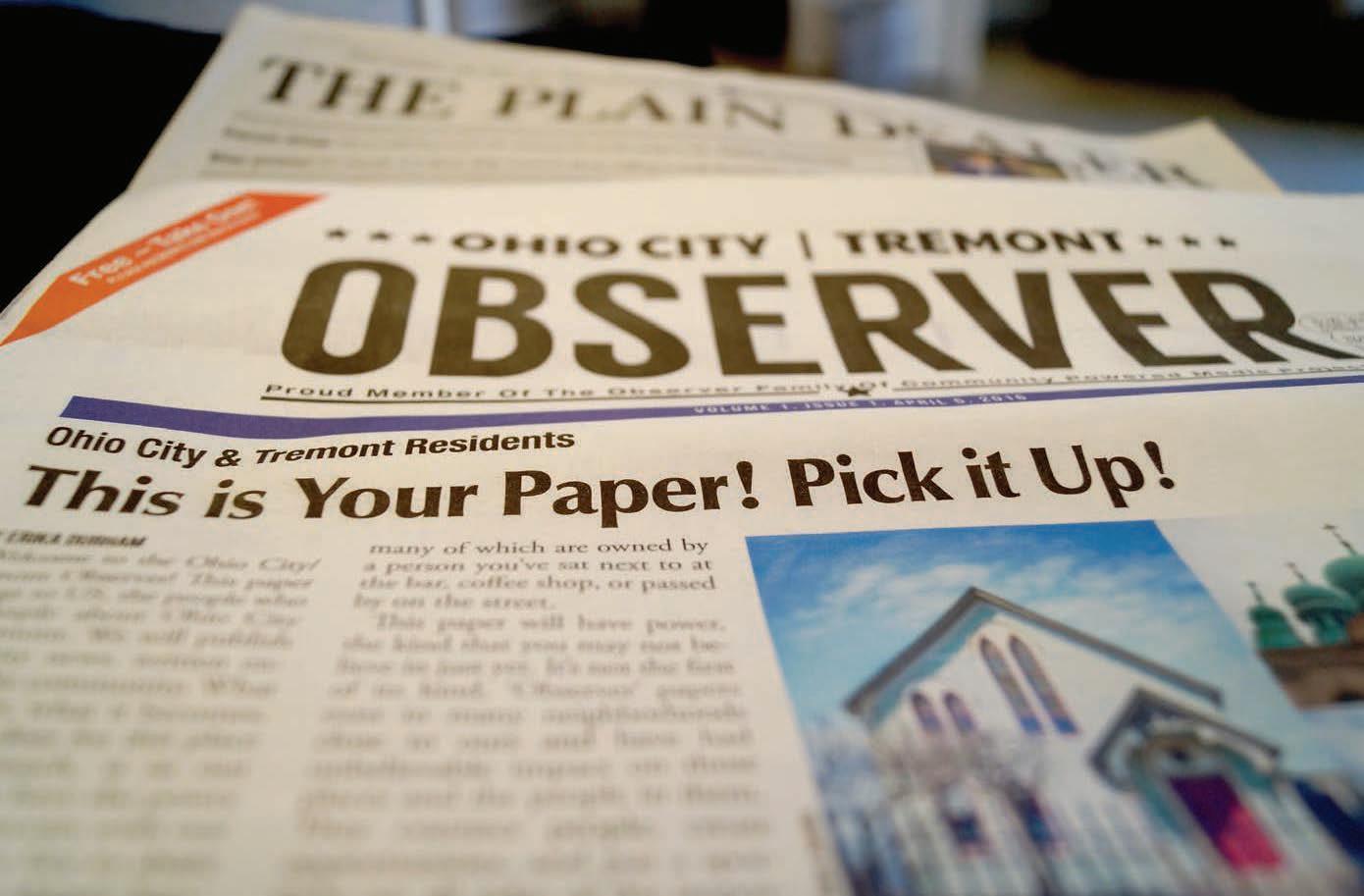
17 minute read
Upfront

UPFRONT UPFRONT
Advertisement



Photo by Sam Allard

NEW NONPROFIT NEWSROOM AIMS TO LAUNCH IN CLEVELAND NEXT YEAR
A COALITION OF LOCAL AND
national organizations has raised nearly $6 million to launch a new nonprofit newsroom in Cleveland in 2022. Spearheaded by the American Journalism Project and the Cleveland Foundation, the new newsroom aims to launch with a staff of 25, which would make it among the largest nonprofit newsrooms in the country and among the largest newsrooms in Cleveland.
In an announcement last week, partners in the effort celebrated the as-yet-unnamed newsroom in the context of the shrinking press corps both locally and nationally and the ramifications on public information and civic participation.
“The crisis of local news in this country cries out for bold, innovative and well-resourced entrepreneurial efforts like the local news initiative we’re announcing today,” said Sarabeth Berman, CEO of the American Journalism Project, in a press release. “We’re grateful to be working with this coalition to get an amazing news organization off the ground.”
The specific flavor and brand of the newsroom is yet-to-be determined and will resolve more sharply into focus when a search committee concludes its national search for an editor-in-chief. The committee, which includes a number of Ohiobased executives in the media and nonprofit spheres, (plus former PD politics writer Henry Gomez), is also searching for a CEO to lead operations statewide. Cleveland is conceived as only the first in a series of Ohio nonprofit newsrooms jointly called the Ohio Local News Initiative.
Like many other nonprofit newsgathering efforts, Cleveland’s will be a digital-only operation at the outset, but will attempt to make its work available in multiple formats. “Center[ing] community voices” will be key, according to the announcement. The newsroom will expand on the work of the Cleveland Documenters project and include a “community reporting model” that hopes to train residents and invite them to set the agenda for editorial priorities.
“Those who control the narratives have significant influence on decisions, and therefore have impact on outcomes,” said Tim Tramble, President and CEO of the Saint Luke’s Foundation, and member of the search committee. “A communitydriven newsroom, operating at high journalistic standards, can serve as a vehicle for everyday people to develop the power to shape their own narratives.”
The newsroom is distinguished from recent local nonprofit journalism experiments foremost by its scope. This is not a coalition of existing newsrooms or a small, geographically targeted community paper. This is a major operation, which should indeed “dramatically increase the volume of original, indepth, non-partisan reporting in the region,” as the press release foretells. Sights have been set on additional fundraising and down-the-road expansion, and the newsroom could immediately compete with the likes of Cleveland.com and Ideastream.
Chris Quinn, editor of Cleveland. com and the Plain Dealer, told Scene he thought any project that added more journalists in Cleveland was “terrific.”
“What we’ve been working towards these last 8-plus years is sustainable journalism in a forprofit model, as we believe the best way to preserve journalism for the long haul is to generate the revenue to keep it healthy,” he wrote in an email. “It’s been a journey, but we’ve made some great strides. The nonprofit model has shown promise elsewhere, and I wish this enterprise great success. Recent years have proven that our democracy is threatened as journalism wanes. I hope these folks thrive.”
Mike McIntyre, Executive Editor of Ideastream Public Media, agreed that another newsroom in Cleveland was exciting news.
“In an era when for-profit media offers far less than it once did, more local journalism that informs and engages audiences is a win for everyone,” he said in a statement.

students,” Cleveland teachers union
“It’s also a key priority at Ideastream president Shari Obrenski told The 74. Public Media. We’re excited to see “They were out for a period of time. It’s what the new Cleveland newsroom produces and stand ready to going to take a while to get a level of collaborate with them, and others, whenever possible for the benefit of stamina where kids are used to being in our community.” -Sam Allard school five days a week.”

Almost Half of all CMSD Students Have Been Chronically Absent This Year
Forty seven percent of Cleveland public school students were chronically absent — missing 10% or more days — in the first seven weeks of the 2021-2022 school year, according to the district.
“We’re seeing larger numbers of that by kids who already had a larger COVID impact than a lot of their more wealthy peers,” CMSD CEO Eric Gordon told The 74. “Yeah, I’m concerned.”
After a virtual year of learning in which more than 8,000 of its students either never showed up, never enrolled, or moved to private schools, a return to in-person classes has seen a staggering rate of absenteeism — more than double its recent pre-pandemic numbers — driven by a few factors, according to Gordon and the Cleveland teachers union.
A poll of CMSD students on the subject of absenteeism found 21% said stress was the cause of missing school, 18% blamed lack of support, 16% were concerned about catching Covid, and 11% said they were unmotivated or lazy.
“Going back to school five days a week seems to be difficult for some of our students,” Cleveland teachers union president Shari Obrenski told The 74. “They were out for a period of time. It’s going to take a while to get a level of stamina where kids are used to being in school five days a week.”
While chronic absenteeism was up in 2020-2021 across the state, rates were higher for schools that did virtual learning as opposed to in-person classes and significantly higher for minority students and those dealing with poverty (38%) than others (11%).
The achievement gap also grew along the same divisions, with those doing all-virtual learning falling further than those in classrooms, and minorities, students with disabilities, and poor students falling further behind than their counterparts, according to statewide data released in October.
“We also know that some of the decreases were more pronounced in districts that were primarily in remote status last year,” Chris Woolard of the Ohio Department of Education told the Statehouse News Bureau. “So we look at the numbers that are definitely down and not surprisingly, it didn’t sort of impact everybody the same. [And] as is the typical pattern for chronic absenteeism, Ohio’s historically underserved and vulnerable students, and students in urban areas, experienced higher rates of chronic absenteeism than their peers.”
Chronically absent students have lower tests scores in reading and math and are 30% less likely to graduate in Cleveland, Gordon told The 74.
Districts around the country and in Northeast Ohio have also seen a rise in behavioral issues, mainly fighting, in schools that were virtual and have since returned to regular classes.
Bedford High School is in the midst of a one-month return to virtual schooling after violence and fights drove the school board to take action.
“Obviously, none of this is ideal,” Bedford schools superintendent Dr. Andrea Celico said in a statement. “As we’ve said, the decision to return temporarily to remote learning for high school students wasn’t easy and it wasn’t made lightly. However, we have to address safety issues. We want our students to feel safe so they can concentrate on learning and we want our teachers and staff to feel secure so they can do their best work too. [Students] are adjusting and many of them are struggling.”
In Akron, schools superintendent Christine Fowler Mack recently sent a letter home to each family discussing the behavioral issues that have become an issue this year and the ways in which the district is using restorative justice, new safety measures and accountability to address them.
“We know with certainty that the poor choices of a few can impact the learning of many, and can even pose a threat to the safety (of) those who are making good choices. For this reason, we must work together to remind all students that those who violate our code of conduct face serious consequences including suspension or expulsion, or in some cases, the possibility of criminal charges,” it read. “While the pandemic has taken an emotional toll on all of us, it’s important to note that its impact is more severe for those who were already the most vulnerable among us. For this reason, I urge empathy in our actions and in our reactions to the behaviors of others.”
Speaking to the Beacon Journal, Akron schools’ student support and security director Dam Rambler said that “smaller incidents, from students being disruptive in class to having short tempers that lead to arguments and fights” has been an issue.
“People go from zero to 50 in the quickest blink for the littlest things,” he said.
In the September State of the Schools address, CMSD CEO Eric Gordon highlighted the many ways the district stepped up for its disadvantaged students and families during the pandemic.
Quoting Noam Chomsky, Gordon talked about the privileged few and desperate many, and how the pandemic forced “the privileged few to confront the stark realities of many poor Americans, including those living here in Cleveland.”
In the city with the highest rate of child poverty in the nation and one of the largest digital divides, “CMSD and our many community partners became lifelines to our families. They worked tirelessly to reach those who not only were cut off from such supports, but who needed them more than anyone. We printed and mailed academic content to our students’ homes, broadcasted lessons on WUABChannel 43, purchased and deployed iPads, Chromebooks and laptops, distributed hotspots to the homes of every CMSD family, and began the process of converting those hotspots to permanent high-speed Internet access as well.”
It will use ARPA funds to continue to make progress on closing the digital divide for its students. It will continue to offer before and after school opportunities for students who fell behind to catch up.
But getting kids who have been missing days back into the classroom is a short-term problem that has him worried.
“The pattern is looking more like last year than it looked like pre-COVID,” he told The 74. “We’re seeing lots more students with offtrack behavior.” -Vince Grzegorek
Progressive Field Deal
Cuyahoga County Council voted 9-1 Tuesday to authorize spending its portion of a $435 million lease agreement with the Cleveland Guardians. The “deal” will keep pro baseball in Cleveland until 2036 — with the possibility of two additional five-year extensions down the road — and will include more than $200 million in maintenance and upgrades at the facility on the corner of Carnegie and Ontario.
The county’s portion includes roughly $9 million per year, harvested from the hotel bed tax (~$3 million), the Sin Tax (~$2.5 million) and the general fund (~$2.5 million) with an additional $300,000 per year coming from sources yet to be determined or publicized. According to the terms announced by the team and its public partners before hearings began, the county will also contribute $11.6 million in upfront one-time payments.
Under the deal’s terms, the city of Cleveland would contribute $8 million per year, and the state of Ohio would chip in $2 million per year, for the 15-year duration of the lease. The deal will not be finalized until it is passed by Cleveland City Council, who began committee hearings on the deal Tuesday.
The choreography and rhetoric of the county council hearings were nearly identical to those in 2017, when the county authorized its portion of the Q Deal.
Just as at that time, council members claimed that the deal was an imperfect solution to a massive problem. Until the “broken system” is improved via national interventions, said Councilman Dale Miller, paying a ransom every few years to keep the facilities in tip-top
shape, thereby avoiding a larger price tag for a new stadium, is a price the county should be willing to pay to keep a vital piece of the city’s historical and cultural fabric intact.
The deal, said Councilwoman Sunny Simon, is “vital to a community of sports fanatics.” Like others, she celebrated the vitality of downtown Cleveland since the arrival of the basketball and baseball arenas.
Others, like County Executive Armond Budish himself, didn’t feel the need to express remorse or reluctance of any kind. He played his part and proclaimed that the deal was necessary to keep the team in Northeast Ohio and that it was the public’s responsibility to maintain a world-class facility because it was a public asset.
Only Councilman Michael Gallagher voted against the deal, saying he believed the county simply could not afford the ongoing contributions. “There comes a time when you have to make a stand,” he said. -Sam Allard
Winners and Losers from the 2021 Election Season Beyond Kevin Kelley and Justin Bibb
Winner: RYAN PUENTE
Ryan Puente, the baby-faced former Executive Director of the Cuyahoga County Democratic Party, was Justin Bibb’s campaign manager. Bibb described him as one of the brightest political minds in America during his victory speech, and he now seems to be in the catbird’s seat, professionally. He could elect to stay on with Bibb’s transition team and could serve as a member of Bibb’s administration if he chose. Alternately, he could leverage the local victory to sign on with, or manage, a campaign on the national stage.
Loser: BASHEER JONES
Ward 7 Councilman Basheer Jones made a grave political miscalculation when he backed Kevin Kelley for mayor in the general election after his own disappointing primary performance. People watched Jones’ Kelley endorsement with a mixture of horror and incredulity. Here was a man who had butted heads constantly with Kelley during his one term on City Council and who, though not always politically savvy, appeared to genuinely care about the most vulnerable members of his community. The Kelley endorsement simply made no sense, which is why many assumed that Jones had been bought, bossed or bothered into supporting the white candidate who’d ignored and stomped on black voters for years. Jones surrendered his council seat to run for mayor, but he surrendered his credibility to support Kelley. He’s liable to remain the face of all those who did so for awhile.
Winner: ZACK REED
Former councilman and mayoral candidate Zack Reed is roughly the photo negative of Jones. Not only did Reed back the right horse after his primary defeat, he also put ego aside to pound pavement. He even put up his own cash to pay for a mailer on the southeast side, where Bibb dominated. Reed made it clear that he was backing Bibb without any commitment for a job in the new administration, and in doing so, came off as a candidate gracious in defeat who remained true to his convictions, someone who sincerely wanted positive change for the city and was willing to work for it.
Loser: DAVE WONDOLOWSKI
DIGIT WIDGET
12
Overdose deaths in Cuyahoga County over the first weekend of November, resulting in a public health alert from the county medical examiner. The County is currently on track to eclipse 700 overdose deaths on the year. 727 – Overdose deaths in Cuyahoga County in 2017, at the height of the Opioid epidemic.
10
Maximum number of balloons that anyone may release outdoors over a 24-hour period, after Cleveland passes an ordinance this week on the subject.
11.3
Acres that will be available for development after the Cleveland Clinic demolishes the Cleveland Play House complex on E. 86th and Euclid. (Currently, the Clinic plans to use the site as an overflow parking lot and staging area for construction materials.)





UPFRONT

Wondolowski is the Broadview Heights-dwelling head of the Building and Construction Trades Council and a sitting member of the Cuyahoga County Board of Elections. Wondo and his fellas, who align politically with Cleveland’s real-estate-development status quo on the basis of keeping construction jobs flowing, naturally backed Kelley in the mayoral election. Wondo uttered one of the more memorable and least prophetic quotes of the season when he complained about biased media coverage and said that Kelley was going to “kick the shit out of” the media and Justin Bibb after he won the election. Wondo had to apologize at the Kelley concession party, saying actually I love the media like a man with a gun to his head, but that won’t prevent the remarks from haunting him for years to come, nor from folks asking serious questions about the role and obligations of members of the Board of Elections.
Winner: NICK CASTELE
Speaking of the media, the bearded and bespectacled Catholic behind the best political reporting of the year has been the belle of the ball for weeks, and deservedly so. “After Jackson: Cleveland’s Next Mayor,” the weekly Ideastream podcast hosted and reported by Castele, was a real pro job. Each week, it masterfully recapped the latest campaign news while contextualizing the race’s biggest issues. Clevelanders interested in this pivotal election got to know and understand the candidates and their platforms because of Castele’s work. Ideastream’s Mike McIntyre has said the podcast established Castele as one of the region’s premiere journalists. The truth is, he’s been among the region’s premiere journalists for years. Now, a lot more people know it. And that includes — I’m terrified to report — hiring managers elsewhere.
Loser: OHIO DEMOCRATS
The arrival of young, smart, passionate Democrats on the Cleveland political scene should be an exhilarating development for the Ohio party, eager to stock the shelves and replenish the empty warehouse in anticipation of upcoming statewide elections. But voter turnout in Cleveland actually declined from 2017, when Frank Jackson mobilized his private machine to secure his fourth term without doing much personal campaigning of any kind. If Cleveland, the so-called Democratic stronghold of Ohio, can’t turn out votes — and if local political figureheads like Frank Jackson, Marcia Fudge and Armond Budish (lol) can’t be bothered to help with anything other than their own campaigns, the continued doom of Ohio, already among the nation’s kookiest and politically barren states, will be assured.
Winner: CLASH
Cleveland Lead Advocates for Safe Housing scored two huge symbolic victories in the defeats of both Kevin Kelley and Ward 12 City Councilman Anthony Brancatelli. Kelley sat atop council as, for years, it ignored the lead paint crisis, even after former councilman Jeff Johnson proposed legislation to do something about it in 2017. Kelley also led the charge to invalidate the CLASH petitions on a legal technicality. Brancatelli, siding with the realtor and landlord lobby, was the only councilperson who voted NO on the lead safe ordinance that ultimately passed. Replacing these two will be Justin Bibb, a candidate who has at least gestured toward the urgency of properly funding and enforcing the lead law on the books, and who has mentioned the lead crisis as a target for ARPA dollars; and Rebecca Maurer, the CLASH activist and attorney who drafted the CLASH legislation on which much of the city’s ordinance was based.
Loser: “DEFUND THE POLICE”
The overwhelming passage of Issue 24 is wind in the sails of those who’ve been demanding police accountability for years — especially those who’ve lost family members to police violence — and a sharp rebuke to the inane “Defund the Police” narrative as deployed by Kelley and his goons. After the racial justice protests of May 30th, it was clear that some form of public safety policy intervention was required, beyond the symbolic “Racism as a Public Health Crisis” resolutions passed locally with much fanfare. Issue 24, which will fund and enhance the powers of a civilian review board in matters of police discipline, became that intervention in Cleveland. And voters said yes, please. -Sam Allard
scene@clevescene.com @clevelandscene








